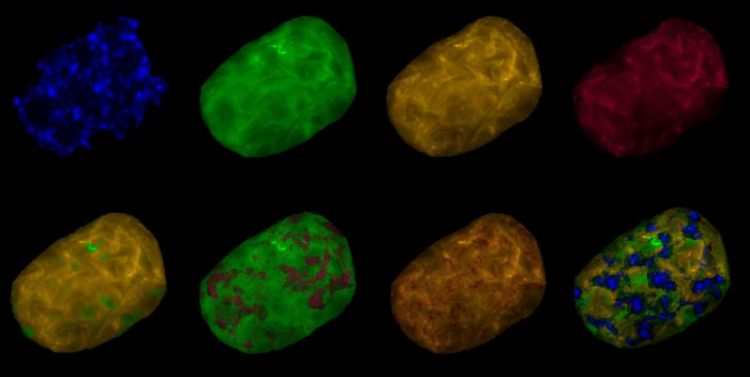Giant bacterium contains genomes for an entire population

Fluorescence in-situ hybridization image of a stained Achromatium oxaliferum cell. Image: Mina Bizic-Ionescu / IGB
Although Achromatium oxaliferum has been known for over a century, its physiology and genetic features remain largely unknown.
A team of researchers from the Leibniz-Institute of Freshwater Ecology and Inland Fisheries (IGB) in Berlin, the Carl von Ossietzky University in Oldenburg and Oxford University found that single cells of Achromatium contain up to 300 DNA spots, each with an undefined number of chromosomes. Single-cell genomes and metagenomic analysis showed that the many chromosomes are not identical copies of one another.
A new dawn for bacteria researchers
Usually environmental samples – such as water or soil samples – are analysed using DNA/RNA sequences. In this process, the different sequences shed light on the types of bacteria contained in a sample. If it is assumed that a polyploid bacterium of a certain type has multiple identical genomes, then the number of different types of bacteria in a water sample will be that of the different genomes.
If, however, the sample also contains Achromatium or similar polyploid bacteria, the method used to date may lead to an overestimation of the true diversity. Where 1000 different bacterial types were once assumed, perhaps there are only 100 or less.
Only a few years ago, it was still believed that single-celled organisms with several genome copies were the exception. In the meantime, however, such organisms are increasingly being “discovered”. The new insights into Achromatium oxaliferum could, therefore, also give an impetus to taking a closer look at cells with few to hundreds genome copies to ascertain whether they are in fact identical copies.
Same same but different
When an Achromatium cell divides, the genomes are likely distributed “randomly” to the daughter cells. This random division should actually cause the new cells to become increasingly dissimilar. And yet how does Achromatium manage to remain the same nonetheless? Strong environmental pressure leads to the preservation of functionality, ensuring the “survival” of Achromatium: mother cells and daughter cells remain the same organisms.
Have a look at the scientist’s blog article on Nature Microbiology to deepen the topic: https://naturemicrobiologycommunity.nature.com/channels/346-behind-the-paper/pos…
Study:
Danny Ionescu, Mina Bizic-Ionescu, Nicola De Maio, Heribert Cypionka, Hans-Peter Grossart (2017): Community-like genome in single cells of the sulfur bacterium Achromatium oxaliferum, Nature Communications 8, Article number: 455 (2017), doi:10.1038/s41467-017-00342-9. http://rdcu.be/vCoK
Contact persons:
Dr. Danny Ionescu, Leibniz-Institute of Freshwater Ecology and Inland Fisheries (IGB), Dept. Experimental Limnology, ionescu@igb-berlin.de, +49 (0) 162 9702 888
Prof. Hans-Peter Grossart, Leibniz-Institute of Freshwater Ecology and Inland Fisheries (IGB), Dept. Experimental Limnology, hgrossart@igb-berlin.de, +49 (0) 33082 699 91/10
About the Leibniz-Institute of Freshwater Ecology and Inland Fisheries (IGB):
Work at IGB combines basic research with preventive research as a basis for the sustainable management of freshwaters. In the process, IGB explores the structure and function of aquatic ecosystems under near-natural conditions and under the effect of multiple stressors. Its key research activities include the long-term development of lakes, rivers and wetlands under rapidly changing global, regional and local environmental conditions, the development of coupled ecological and socio-economic models, the renaturation of ecosystems, and the biodiversity of aquatic habitats. Work is conducted in close cooperation with universities and research institutions from the Berlin/Brandenburg region as well as worldwide. IGB is a member of the Forschungsverbund Berlin e.V., an association of eight research institutes of natural sciences, life sciences and environmental sciences in Berlin. The institutes are members of the Leibniz Association. http://www.igb-berlin.de
Media Contact
All latest news from the category: Life Sciences and Chemistry
Articles and reports from the Life Sciences and chemistry area deal with applied and basic research into modern biology, chemistry and human medicine.
Valuable information can be found on a range of life sciences fields including bacteriology, biochemistry, bionics, bioinformatics, biophysics, biotechnology, genetics, geobotany, human biology, marine biology, microbiology, molecular biology, cellular biology, zoology, bioinorganic chemistry, microchemistry and environmental chemistry.
Newest articles

NASA: Mystery of life’s handedness deepens
The mystery of why life uses molecules with specific orientations has deepened with a NASA-funded discovery that RNA — a key molecule thought to have potentially held the instructions for…

What are the effects of historic lithium mining on water quality?
Study reveals low levels of common contaminants but high levels of other elements in waters associated with an abandoned lithium mine. Lithium ore and mining waste from a historic lithium…

Quantum-inspired design boosts efficiency of heat-to-electricity conversion
Rice engineers take unconventional route to improving thermophotovoltaic systems. Researchers at Rice University have found a new way to improve a key element of thermophotovoltaic (TPV) systems, which convert heat…



